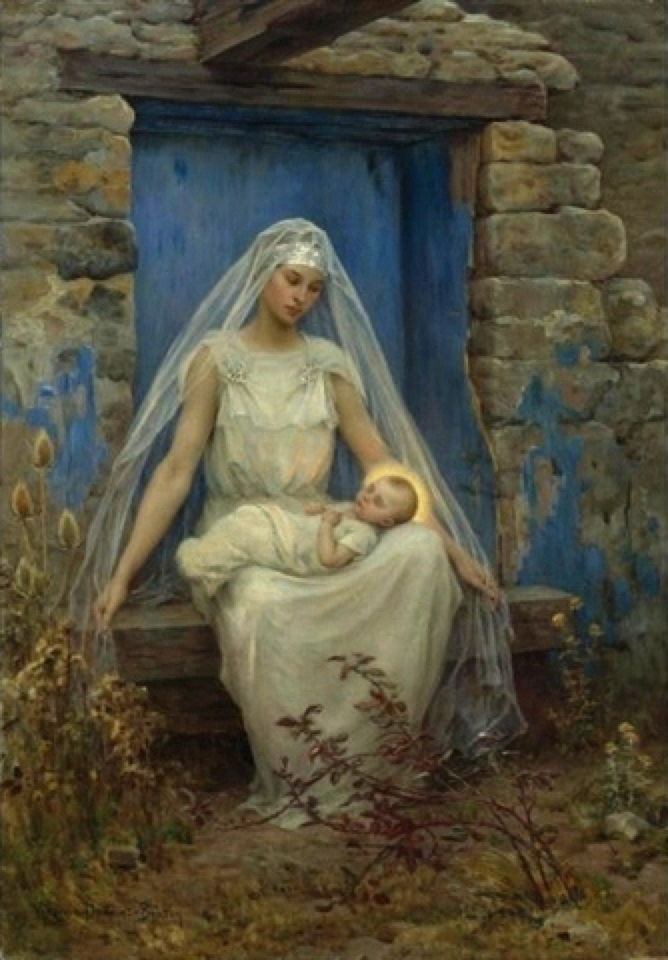Reading visual art: 160 Birth

Despite the hopes of the taxman, there really only are two certainties in life, that everyone alive was born, and we’ll every one of us die. This week, in this series examining how to read visual art, those two events are my themes, starting today with birth, the less frequently painted of the two.
There are several notable if not downright bizarre births among classical myths. The first are the twin deities Diana and Apollo born to the goddess Latona.
Annibale Carracci (1560–1609), Latona and the Lycian Peasants (date not known), oil on canvas, 90.6 x 78 cm, Arcidiecézní muzeum Kroměříž, Olomouc Museum of Art, Kroměříž, The Czech Republic. Wikimedia Commons.
Annibale Carracci’s Latona and the Lycian Peasants probably from 1590-1620 shows the mother remonstrating with Lycians who are preventing her from slaking her thirst. Latona is here placing her curse on the locals, and behind them one appears to have already been transformed into a frog, the fate that befell them all.
The origin of the goddess Venus must have stretched the imagination of many ancients, as she is supposed to have emerged in full-size adult form from sea foam produced from the severed genitals of Uranus, leading to the popular visual account as Venus Anadyomene, Venus rising from the sea.
Sandro Botticelli (Alessandro di Mariano di Vanni Filipepi) (c 1445-1510), The Birth of Venus (c 1486), tempera on canvas, 172.5 x 278.9 cm, Galleria degli Uffizi, Florence. WikiArt.
The first known painting of Venus Anadyomene is thought to have been made by the Greek artist Apelles, but was lost long before the modern era. In Botticelli’s Birth of Venus from about 1486, she stands in an over-sized clamshell, naked and beautiful, her long tresses blowing in the breeze while crucially ‘covering her modesty’.
Joseph Stella (1877–1946), The Birth of Venus (1922), oil on canvas, 215.9 x 134.6 cm, Private collection. The Athenaeum.
Joseph Stella’s treatment of The Birth of Venus is completely novel and seems to have benefited from visits to an aquarium. She is shown at sea, her human figure perfect above the waterline, below that morphing into an aquatic plant, and finally merging into a helical shell rather than the traditional clam.
Of all the Classical deities, Bacchus (or Dionysus) must have the least credible origin. He was the result of another of Jupiter’s extramarital relations, this time with the mortal Semele. She seems to have been incredulous as to the true identity of her lover, and trapped him into having to reveal himself to her in his full divine majesty. Knowing that would inevitably kill her, he tried to dissuade her, which could only have fuelled her suspicions. Despite bringing only his weakest thunderbolts, the inevitable happened, and she was consumed by fire, but not before Jupiter could perform a Caesarian section on her and remove their unborn son Bacchus. The head of the Olympian deities then sewed his son’s foetus into his thigh to continue to term, when Bacchus was born a god.
Giulio Romano (Giulio Pippi) and Workshop (c 1499-1546), The Birth of Bacchus (c 1535), oil on panel, 126.4 × 79.4 cm, The J. Paul Getty Museum, Los Angeles, CA. Courtesy of The J. Paul Getty Museum.
Giulio Romano and his workshop’s Birth of Bacchus (c 1535) is a wonderful and revealing depiction of contemporary midwifery practice. Jupiter, at the upper right, seems to be fleeing the scene, thunderbolts in his right hand, and Juno, at the upper left, seems puzzled and upset. Down on earth, Semele has just been delivered of a baby boy, Bacchus, and her four attending midwives are caring for the baby, busy with the traditional towels and water as they do. However, above Semele’s abdomen and right thigh there are flames rising, and smoke. She looks up at Jupiter in distress if not horror. He isn’t stopping to take on any surrogate pregnancy, though, and Bacchus looks full-term too, hardly in need of further gestation.
While we’re stretching credibility, the story of Leda’s children is also extraordinary.
Unknown follower of Leonardo da Vinci (1452–1519), Leda and the Swan (early 1500s), oil on panel, 131.1 × 76.2 cm, Philadelphia Museum of Art, Philadelphia, PA. Wikimedia Commons.
This interpreted copy of Leonardo da Vinci’s Leda and the Swan, probably painted in the early 1500s and now in the Philadelphia Museum of Art, summarises Helen’s unique birth. The outcome of the union of Leda, wife of the king of Sparta, with Jupiter, in the form of a swan, Helen didn’t have a normal birth, but hatched from an egg laid by her human mother. Some accounts claim that Leda had intercourse with both the swan and her husband Tyndareus on the same night, and produced one or two eggs containing Helen, Clytemnestra, Castor and Pollux, as shown here.
If you find that hard to believe, can I offer you Adonis, who was born from a myrrh tree? Myrrha’s incestuous relationship with her father led to her pregnancy and punishment by transformation into the myrrh tree, from which came forth Adonis.
Marcantonio Franceschini (1648–1729), The Birth of Adonis (c 1692-1709), oil, dimensions not known, Kunstmuseum Liechtenstein, Vienna, Austria. Wikimedia Commons.
Marcantonio Franceschini’s Birth of Adonis from around 1692-1709 adopts an appropriately vertical composition. Diana is handing Adonis over to another goddess, possibly Venus, who is preparing to take the role of wet-nurse, an obligatory task when your mother is a tree. Behind them are two women looking in amazement, and Pan and a satyr are providing appropriately celebratory music.
Having prepared you with adults born from sea foam and babies hatched from eggs, the Christian Nativity should now seem relatively mundane.
Duccio di Buoninsegna (1255–1319), The Nativity with the Prophets Isaiah and Ezekiel (1308-11), tempera on panel, 48 x 87 cm, National Gallery of Art, Washington, DC. Wikimedia Commons.
It’s probably Duccio’s Nativity with the Prophets Isaiah and Ezekiel from 1308-11 that formed the prototype for centuries of subsequent paintings, with its humble shed set into rock, the Holy Family, and the attendant animals (ox, ass, sheep) and humans (shepherds, angels). This was installed at the high altar in the Duomo (cathedral) in Siena on 30 June 1311, and remained there for nearly two centuries, only being removed in 1506. Each panel has its own apposite Latin inscription.
Robert Campin (1375/1379–1444), The Nativity (c 1415-1430), oil on panel, 84.1 × 69.9 cm, Musée des Beaux-Arts, Dijon, France. Wikimedia Commons.
Inevitably, when oil painting arrived in the Northern Renaissance, the Nativity was one of the first themes, here painted by Robert Campin some time between 1415-30. This is also an early example in which the scene has moved out from the cave that had become popular in southern Europe, to a shed more typical of local farms. The sparse background of earlier Nativities has been replaced with a landscape typical of the coast of northern Europe.
Virginie Demont-Breton (1859–1935), Alma Mater (date not known), oil on canvas, 92.5 x 66 cm, location not known. Wikimedia Commons.
That immensely popular motif of the Virgin Mary and the infant Jesus has changed considerably over the years, through Raphael’s lifelike and intimate Madonnas, and again into the late nineteenth century with Virginie Demont-Breton’s contemporary reinterpretation in her undated Alma Mater. She looks very young, and there is no sign of Joseph, just her obviously holy infant lying swaddled on her lap. Around her are the weeds of waste and derelict sites.
Louis Janmot (1814–1892), The Angel and the Mother (Poem of the Soul 3) (1854), oil on panel, dimensions not known, Musée des Beaux-Arts, Lyon, France. Courtesy of Musée des Beaux-Arts, via Wikimedia Commons.
The third painting in Louis Janmot’s epic series Poem of the Soul is curiously titled The Angel and the Mother without reference to its real subject, the baby. This is set by the Lake of Moras, where the mother sits with the newborn soul on her lap. Its guardian angel is kneeling in prayer for the mother and the soul of her new child. This combines the images of the annunciation to the Virgin Mary, and the Virgin Mary with the infant Jesus.
Although many artists have painted their own infants and children, I know of only one showing the artist’s son immediately following birth.
Ford Madox Brown (1821–1893), Take your Son, Sir! (1851-52), oil on canvas, 70.5 x 38.1 cm, The Tate Gallery (Presented by Miss Emily Sargent and Mrs Ormond in memory of their brother, John S. Sargent), London. © The Tate Gallery and Photographic Rights © Tate (2016), CC-BY-NC-ND 3.0 (Unported), https://www.tate.org.uk/art/artworks/brown-take-your-son-sir-n04429
The dates and background to Ford Madox Brown’s incomplete painting Take your Son, Sir! remain unclear. It’s thought that Brown started work on this in 1851, although it shows his second wife Emma with their newborn son. Their first son, Oliver, wasn’t born until 1855, and their second, Arthur, in September 1856, suggesting that he didn’t start this until at least 1855. It’s generally held that this shows not Oliver, who lived until 1874, but Arthur, who died aged ten months in July 1857, at which time Brown abandoned the painting.
It’s most interesting for the detail seen reflected in the mirror, showing a contemporary living room and a man, presumably a self-portrait. This is reminiscent of Jan van Eyck’s Arnolfini Wedding (1434). The artist’s wife appears to be pale and flushed, as if her labour wasn’t free of incident either.




